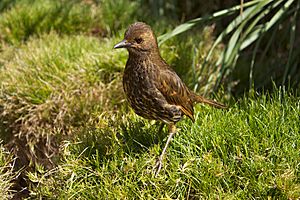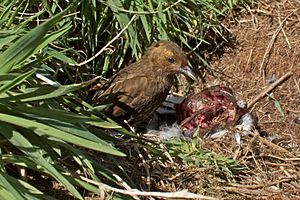Tristan thrush facts for kids
Quick facts for kids Tristan thrush |
|
|---|---|
 |
|
| On Nightingale Island | |
| Conservation status | |
| Scientific classification | |
| Synonyms | |
|
The Tristan thrush (Turdus eremita), sometimes called the starchy, is a special type of bird. It lives only on the Tristan da Cunha archipelago, a group of islands far out in the South Atlantic Ocean. These islands are a British territory. This bird belongs to the thrush family.
Contents
What Does the Tristan Thrush Look Like?
This thrush is about 22 cm (8.7 in) long. That's about the length of a standard ruler. It was first described by a scientist named John Gould. He said it looked similar to a song thrush, but darker.
The Tristan thrush has short, rounded wings. Its body shape shows it doesn't need to fly long distances. This is common for birds that live on small islands.
Differences Between Island Thrushes
Birds from Tristan da Cunha island are warm dark brown on their backs. Their heads are a reddish-brown color. Their undersides are also reddish-brown.
However, thrushes from Nightingale Island look a bit different. They are a duller, sooty-brown on their backs. Their heads are darker, and their undersides are brownish-black. Birds from Inaccessible Island are a mix of these two looks.
Where Does the Tristan Thrush Live?
The Tristan thrush lives on several islands in the Tristan da Cunha group. These include Tristan, Inaccessible, Nightingale, Middle, and Stoltenhoff Islands.
It uses all the natural places available on these islands. You can find it on rocky shorelines and in grassy areas. It also lives in places with lots of ferns and wet heathland.
How Is the Tristan Thrush Related to Other Birds?
Scientists believe the Tristan thrush came from an ancestor in the Turdus genus. This ancestor likely came from South America. The Tristan thrush looks a bit like a young austral thrush.
For a while, some thought it should be in its own special group. This was because it has a unique brush-tipped tongue. This tongue helps it get food from inside eggs. But new studies show it is definitely part of the Turdus group.
Tristan Thrush Subspecies
There are three different types, or subspecies, of the Tristan thrush. Each type lives on one of the main islands:
- T. e. eremita (found on Tristan da Cunha)
- T. e. gordoni (found on Inaccessible Island)
- T. e. procax (found on Nightingale, Middle, and Stoltenhoff Islands)
Tristan Thrush Behaviour
Reproduction and Life Cycle
The Tristan thrush breeds from September to February. It builds a cup-shaped nest from grass and other plants. The nest is usually on the ground or very close to it.
The female thrush lays two or three eggs, sometimes four. The young birds leave the nest after about 20 days. This is called the fledging period.
What Does the Tristan Thrush Eat?
The Tristan thrush eats many different things. It is an omnivore, meaning it eats both plants and animals. It's also a scavenger, eating things it finds.
It eats earthworms and other small creatures found in the soil. It also eats dead animals, berries, and even leftover food from people. Sometimes, it eats the eggs and young birds of other species.
Eating Other Birds' Eggs
Scientists have seen Tristan thrushes breaking open the eggs of large seabirds. For example, they have been seen eating eggs from the Atlantic yellow-nosed albatross. They also regularly eat the eggs and small chicks of the great shearwater.
These thrushes can even find eggs of the spectacled petrel inside their underground nests. They are also known to hunt and kill small storm petrels. Sometimes, they have even been seen drinking blood from penguins.
Status and Conservation
The Tristan thrush is listed as "near threatened". This means its population is small and lives in a limited area.
One big threat is black rats on Tristan da Cunha island. These rats can eat the thrush's eggs and young. Luckily, the other islands where the thrush lives do not have rats. Wild feral cats used to be a problem on Tristan, but they have been removed.
Protecting the Tristan Thrush
BirdLife International, a conservation group, has made some suggestions to help the thrush. They recommend keeping an eye on the population numbers. They also suggest controlling rats on Tristan da Cunha. It's also very important to stop new animal predators from being brought to the islands.
How Many Tristan Thrushes Are There?
A survey in the 1970s estimated the populations on different islands. Tristan had 40–60 pairs, Inaccessible had 100–500 pairs, and Nightingale had 300–500 pairs. Middle Island had 20–40 pairs, and Stoltenhoff had 10–20 pairs.
Later, in the 1980s, the number on Inaccessible Island was updated to 850 pairs. The total number of thrushes across all islands was estimated to be about 6,000 birds. More recently, there are thought to be several hundred birds on Tristan da Cunha. The good news is that the population seems stable and is not decreasing.
See also
 In Spanish: Zorzal de Tristán de Acuña para niños
In Spanish: Zorzal de Tristán de Acuña para niños



